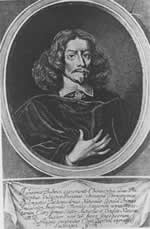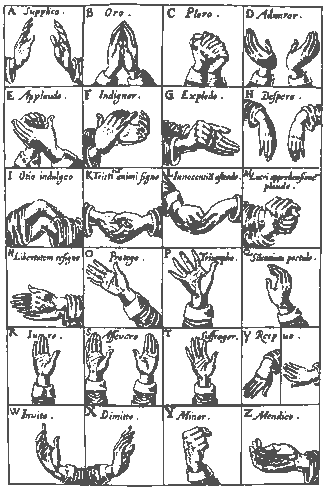John Bulwer
1606-1656
 John Bulwer was a British physician and rhetorician who, between 1644 and 1654 published four works: Chirologia (1644), a study of the human gesture system, Philocophus (1648) a commentary on the education of deaf children, Pathomytomia (1649), a study of the physical expression of emotion, and Anthropomeamorphosis (1650), an indictment of those who change the natural form of the human body.
John Bulwer was a British physician and rhetorician who, between 1644 and 1654 published four works: Chirologia (1644), a study of the human gesture system, Philocophus (1648) a commentary on the education of deaf children, Pathomytomia (1649), a study of the physical expression of emotion, and Anthropomeamorphosis (1650), an indictment of those who change the natural form of the human body.
In Chirologia, Bulwer argued that the neurophysiological bases of gesture was the “universal language” for everyone, not just those who were deaf. He followed the philosophy of Francis Bacon who saw gesture as a “transient hieroglyphic” a way to bypass natural language by symbolizing things directly. He described how the hand can be used to express both words and abstract concepts.
Bulwer was the first to propose an "academy of the mute" and the first Englishman to advocate speech reading and teaching speech to deaf children. He was the first in history to recommend the use of lip reading by the deaf adult. He developed a technique for lip-reading, in his Philocophus and described how the deaf can enjoy music by listening to it through their teeth. This was the first book written in English on deafness and language disability. He also developed a manual alphabet:
Bulwer’s manual alphabet

When writing about emotions in his 1649 book Pathomytomia, Bulwer offered a theory of the expressions of emotions that is not unlike information processing theories of today. He hypothesized a three stage mechanical processing model for emotional expression. In the first, sensory information is conveyed to the brain. In the second there a reflex-like judgment is made about whether the sensory information is harmful or beneficial, and that judgment triggers motions in the body and mind. During the third stage, these body motions are conveyed to the soul, where an image is experienced in consciousness. This third stage also involves the dispersal of motions throughout the body, changing vital physiological system (Bulwer, 1649, Green & Tassinary, 2002, p. 278).
Bulwer’s likened the brain’s relationship to muscle movement to the rider’s relationship with his horse. Here is his theory in his own words:
The brain commandeth as soon as it hath judged whether the thing is to be avoided or prosecuted, the nerves commonly called illatores of the posts, for the intelligence they give, bring the commandment, and faculty; the muscle illustrated with animal spirits obeys, and moves the part according to the command of the will: and as a rider by the moving of his reins, guides his horse, so the fore of the soul residing in the brain, moves the muscles by the nerves, as with reins (Bulwer, 1649, pp. 13-14).
In Pathomytomia, Bulwer described the possible facial expressions of an angry person. He commented that the person is apt to:
- Bend the Brows from the Sinicput to the Eyebrows, which are then knit about the Nose (p. 147);
- Blow up and downe his nostrils with wind, with which sudden and fiery sufflations the nostrils seeme to smoke (p. 196);
- Open the Mouth and lift up their upper Lips (p. 213);
- Gnash and grind with their teeth and to set them so firmly together that the Cheekes are drawn into adverse partes (p. 228) (reprinted in Cleary, 1959, p. 397).
Writings of Bulwer, arranged chronologically
Bulwer, J. (1644) Chirologia, or, The naturall language of the hand, and Chironomia or the art of manual rhetoric. London: Tho. Harper. Reprinted in 1974 by J. Cleary, Ed. Carbondale: Southern Illinois University Press.
Bulwer, J. (1648) Philocopus, or the deaf and dumbe mans friend , London: Humphrey and Moseley. Frontspiece London: Humphrey Moseley.
Bulwer, J. (1649). Pathomyotomia: Or a dissection of the significative muscles of the affections of the mind. London: Humphrey Moseley.
Bulwer, J. (1650). Anthropometamorphosis: Man transform’d; or the artificial changling. London: J. Hardesty.
Bulwer, J. (1653). Anthropometamorphosis: Man transform’d; or the artificial changling: A view of the whole peoples of the world. London: William Hunt.
Writings about John Bulwer—alphabetically arranged
Cooper, T. (1937-1938). Bulwer, John. In Dictionary of National Biography (Vol 3, pp. 262-264). London: Oxford University Press.
Cleary, J. (1959). John Bulwer: Renaissance communicationist. Quarterly Journal of Speech, 45, 391-398.
Green, T. R. & Tassinary, L. G. (2002). The mechanization of emotional expression in John Bulwer’s Pathomyotomia. American Journal of Psychology, 114, 275-299.
Norman, H.J. (1943) John Bulwer (fl. 1654) the "Chirosopher." Pioneer in the treatment of the deaf and dumb in psychology. Proceedings of the Royal Society of Medicine (Section: History of Medicine), 36 (1943), pp. 15-28.
Wollock, Jeffrey.(1996). John Bulwer and his Italian sources. In Mirko Tavoni (Ed.) Italia ed Europa nella linguistica del Rinascimento, vol.2., pp. 417-433. Modena: Panini.
Wollock, Jeffrey (1996). John Bulwer's (1606-1656) place in the history of the deaf. Historiographia Linguistica 23.1/2:1-46.
Wollock, Jeffery (2002). John Bulwer (1606-1656) and the significance of gesture in 17th century theories of language and cognition. Gesture, 2, 2, 227-258.
